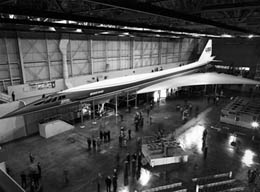On December 31, 1966, the federal government selects Boeing to design and produce a prototype supersonic transport, or SST, for civil airline use. Boeing beats out Lockheed with a radical variable geometry, or "swing-wing," design. The company anticipates major airline sales of the 350-seat aircraft, which is dubbed the Boeing 2707.
On November 18, 1969, the United States House of Representatives approved funding for the Boeing SST, which was expected to employ 25,000 in the Seattle area.
The project later encountered serious technical, environmental, and financial problems. Boeing had to abandon its swing-wing for a more conventional delta wing design, and cost overruns fueled Congressional criticism. The U.S. Senate rejected essential funding in December 1970, leading to the project's cancellation and the onset of the "Boeing Bust" recession.
The Soviet Union was the first nation to complete an SST, the TU-144, which took its maiden flight on December 31, 1968, but the troubled plane saw only limited use. Great Britain and France collaborated on the Concorde SST, and the first of a dozen aircraft entered commercial service in 1976. The Concordes were grounded after a fatal crash near Paris on July 25, 2000.
While the United States has produced many supersonic military aircraft, it has yet to build a civilian SST.

